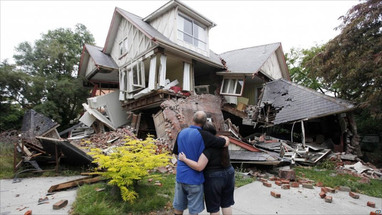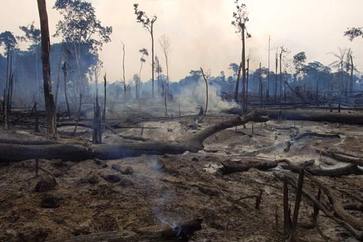Brazil vs. New Zealand!
Environmental Damage a.k.a. Mother Nature Beat Down!
New Zealand: 7
New Zealand has been an earthquake and volcano hotspot since the beginning of its existence due to its location atop the Australian and Pacific plates. However, the severity of these plate interactions has increased in recent years as shown by the 2011 Christchurch earthquake that killed 165 and small 2006 Mt. Ruapehu eruption that killed 3.
Another set of environmental problems plaguing the nation are of the partially man-made variety. When New Zealand was first settled it was covered in trees and since then each of the unique cultures that attempted to live on the land have gone about chopping them all down. Deforestation is a major problem for the region that started in the 1800s when multitudes of settlers came over and chopped down trees to make homes, tools, and create farming space. The practice has continued since then, granted at a steadily decreasing rate, resulting in continued high levels of deforestation. The loss of the trees has also caused several other problems within this fragile ecosystem, most notably soil erosion.
Soil erosion is a naturally occurring process that has been greatly accelerated with the assistance of man, his axe, and domesticated animals. The two leading causes for this rapid erosion are deforestation, as mentioned above, and overgrazing. The trouble with this hastened version of nature's work, as determined by the New Zealand Ministry for Environment, is that it is more difficult to reverse and a great more destructive to crops, farms, and the land as a whole in both a short-term and long-term sense.
New Zealand has always been a nation privy to earthquakes, volcanoes, and soil erosion but recent years has brought about much more detrimental versions of these natural occurrences, much of which can be traced back to the New Zealand peoples.
Another set of environmental problems plaguing the nation are of the partially man-made variety. When New Zealand was first settled it was covered in trees and since then each of the unique cultures that attempted to live on the land have gone about chopping them all down. Deforestation is a major problem for the region that started in the 1800s when multitudes of settlers came over and chopped down trees to make homes, tools, and create farming space. The practice has continued since then, granted at a steadily decreasing rate, resulting in continued high levels of deforestation. The loss of the trees has also caused several other problems within this fragile ecosystem, most notably soil erosion.
Soil erosion is a naturally occurring process that has been greatly accelerated with the assistance of man, his axe, and domesticated animals. The two leading causes for this rapid erosion are deforestation, as mentioned above, and overgrazing. The trouble with this hastened version of nature's work, as determined by the New Zealand Ministry for Environment, is that it is more difficult to reverse and a great more destructive to crops, farms, and the land as a whole in both a short-term and long-term sense.
New Zealand has always been a nation privy to earthquakes, volcanoes, and soil erosion but recent years has brought about much more detrimental versions of these natural occurrences, much of which can be traced back to the New Zealand peoples.
Brazil: 5
Brazil is not doing well environmentally. Deforestation is a major problem in country which is one of the many homes of the Amazon rainforest, the largest rainforest on Earth. 17% of the forest has been removed over the years and when that number reaches 20%, the rainforest will no longer be able function as it should. (A rainforest that is responsible for 1/5 of the world's rainfall.) Though the rates of removal have greatly decreased, they have not stopped altogether and are still proving problematic.
Much of the tree removal was done to create space for farming, particularly soy bean farming (Brazil is one of the largest soy producers in the world), cattle ranches, whose presence often leads to overgrazing which results in soil erosion, and by loggers who sold the trees on the black market.
Another environmental problem facing Brazil is pollution caused by the rapid growth of many major cities. As these cities grew, several of whom are located on land ill-equipped to provide for the population living on it, so did the pollution, air and water pollution being the largest.
Brazil is a growing nation forced to prioritize which areas in the direst need and environmental protection has been thrown to the backburner.
Much of the tree removal was done to create space for farming, particularly soy bean farming (Brazil is one of the largest soy producers in the world), cattle ranches, whose presence often leads to overgrazing which results in soil erosion, and by loggers who sold the trees on the black market.
Another environmental problem facing Brazil is pollution caused by the rapid growth of many major cities. As these cities grew, several of whom are located on land ill-equipped to provide for the population living on it, so did the pollution, air and water pollution being the largest.
Brazil is a growing nation forced to prioritize which areas in the direst need and environmental protection has been thrown to the backburner.


